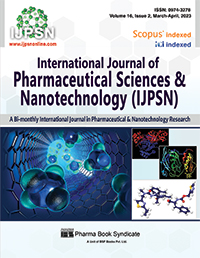In- Silico Drug Design and Molecular Docking Studies of Poly ADP-Ribose Polymerase (PARP-1) Inhibitors as Anticancer Agents
DOI:
https://doi.org/10.37285/ijpsn.2023.16.2.2Abstract
Background of the Topic: Drug discovery employs bioinformatics and computational biology (CADD) approaches for the identification and optimization of lead compounds. The PARP-1 is the member of the PARP family. PARP-1 is the enzyme that repairs the DNA damage in cancer cell hence it is selected as the target for the study. PARP inhibitors were shown the prominent results in the treatment of different kinds of malignancies due to loss of function of BRCA1/2 genes.
Methodology: Based on literature review, database search, ADME and MD simulation, top 10 selected ligands were screened and tested against PARP-1 (4R6E) protein using molecular docking (Glide and Gold software), protein ligand interaction by LIGPLOT analysis. Molecular simulation studies were performed using DESMOND software afterwards on the top compound (CHEMBL378794).
Results: All top 10 compounds showed binding affinity based inhibitory potential against the PARP-1 protein. The highest binding affinities from top 10 compounds towards anticancer targets were exhibited by CHEMBL378794 and CHEMBL245559.
Discussion: The comparative analysis of 4R6E and the identified hits using MD simulation exhibited better stability of the binding domain with these molecules suggesting their strong interaction and selectivity towards PARP-1.
Conclusion: This study showed the significant results in cancer treatment and their strong interaction with PARP-1 binding BRCT domain. Hence, these molecules could further be carried forward to explore their potency against PARP-1 sensitive cancer.
Downloads
Metrics
Keywords:
PARP-1, Niraparib, CADD, ligand, molecular docking, 4R6E, BRCA-1, BRCA-2Downloads
Published
How to Cite
Issue
Section
References
Hung JH, Hsin WY, Chien YC, Chih HH,Hsin YC, Kuei JL, Fuu JT and Calvin YCC (2010). Current development of computer aided drug design. J Taiwan Inst Chem Eng 41: 623-635.
Peter B, Ingrid VDH, Hanneke VDG, Roebi DB, Merel EB, Setareh M, Lodewyk FAW, Maaike PGV and Jos J (2020).Functional Categorization of BRCA1 Variants of Uncertain Clinical Significance in Homologous Recombination Repair Complementation Assays. Clin Cancer Res 26: 4559-4568.
Yorley D, Valeria MM, Matthieu JM and Fernando GN(2019). Integration of target discovery, drug discovery and drug delivery: A review on computational strategies. Wiley Interdiscip Rev NanomedNanobiotechnol 11: e1554.
Ghada FE, Enayat EA, Fadi MA and Samir MEM(2019). Design and synthesis of novel parp-1 inhibitors based on pyridopyridazinone scaffold. Bioorg Chem87: 655-666.
Chandan K, Lakshmi PTV and Annamalai A (2019). Structure based pharmacophore study to identify possible natural selective PARP-1 trapper as anti-cancer agent. Comput Biol Chem 80: 314-323.
G Madhavi S, Matvey A, Tyler D, Ramakrishna A and Woody S (2013). Protein and ligand preparation: Parameters, protocols, and influence on virtual screening enrichments. J Comput Aid Mol Des 27 (3): 221-234.
Noeris KS, Roberto N and Woody S (2009).Novel method for generating structure-based pharmacophore using energetic analysis. J Comput aided Mol Des 49: 2356- 2368.
Gang F, Prasanna S, Olivia RD, Susan PM, Stephen JC and Robert JD (2014). Pharmacophore modeling ensemble docking virtual screening and biological evaluation on Glycogen synthase kinase-3 beta. Mol Inform 33: 610-626.
LigPrep, Schrödinger, LLC, New York, NY, 2020.
Jens S and Johann G (1993).From atoms and bonds to the three-dimensional atomic co-ordinates; automatic model builders. Chem Rev 93: 2567-2581.
Jeremy RG, David C, Arron PS and John CS (2010).Towards the comprehensive, rapid, and accurate prediction of the favorable tautomeric states of drug-like molecules in aqueous solution. J Comput Aided Mol Des 24: 591-604.
Maestro, Schrödinger, LLC, New York, NY, 2020.
Marcel LV, Jason CC, Michael JH, Christopher WM and Richard DT (2003).Improved Protein-Ligand Docking Using GOLD. PROTEINS: Struct Funct Genet 52:609-623.
Roman AL and Mark BS (2011). LigPlot+: Multiple Ligands – Protein Interaction Diagrams for Drug Discovery. J Cheminformatics 51: 2778–2786.
The PyMOL Molecular Graphics System, Version 2.0 Schrödinger, LLC, New York, NY, 2016.
Antoine D, Olivier M and Vincent Z (2017). SwissADME: a free web tool to evaluate pharmacokinetics, drug-likeness and medicinal chemistry friendliness of small molecules Sci Rep 7(42717): 1‒13.
Kevin JB, David EC, Huafeng X, Ron OD, Michael PE, Brent AG, John LK, Istvan K, Mark AM, Federico DS, John KS, Yibing S and David ES (2006). Scalable Algorithms for Molecular Dynamics Simulations on Commodity Clusters. Proceedings of the ACM/IEEE Conference on Supercomputing (SC06), Tampa, Florida 11-17.
Ishikawa K, Ishii H and Saito T (2006).DNA damage-dependent cell cycle checkpoint and genomic stability. DNA Cell Biol 25: 406-411.
Yves P, Mark JOC and Johann DB (2016). Laying a trap to kill cancer cell: PARP inhibitors and their mechanisms of action. Sci Transl Med 8: 362.
Jennine MDM, Marie FL, Jamie ED, Amanda AR, Connie DC, Kelly RK, Michael M, Jamin DS, Ben EB and John MP (2005). PARP-1 activation requires local unfolding of an Autoinhibitory Domain. Mol Cell 60: 755-768.
Batchimeg N, Khosbayar T and Takayuki S (2016). Base excision repair pathway and polymorphism of XRCCl gene. J Mol Pathol Epidemiol 1: 1-4.






